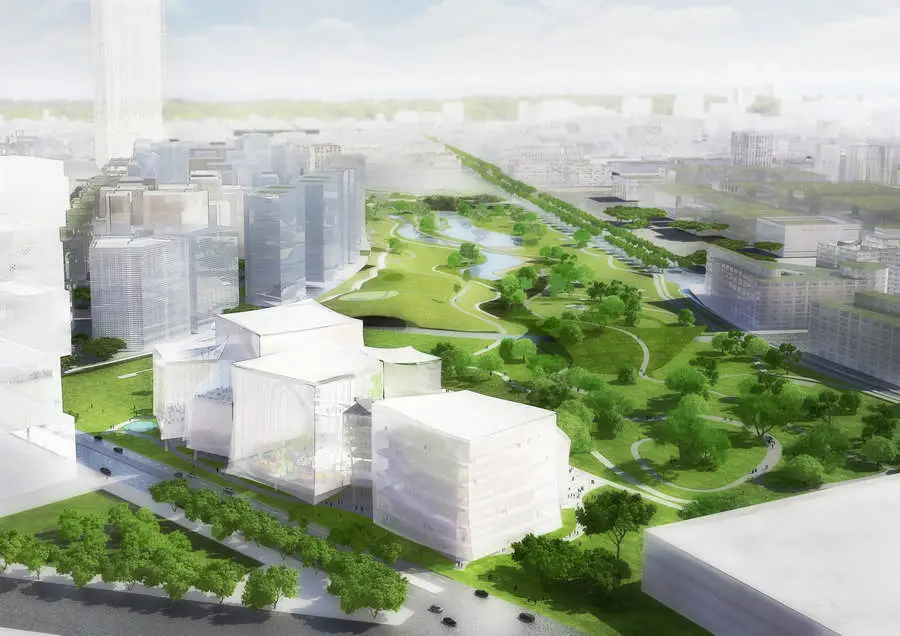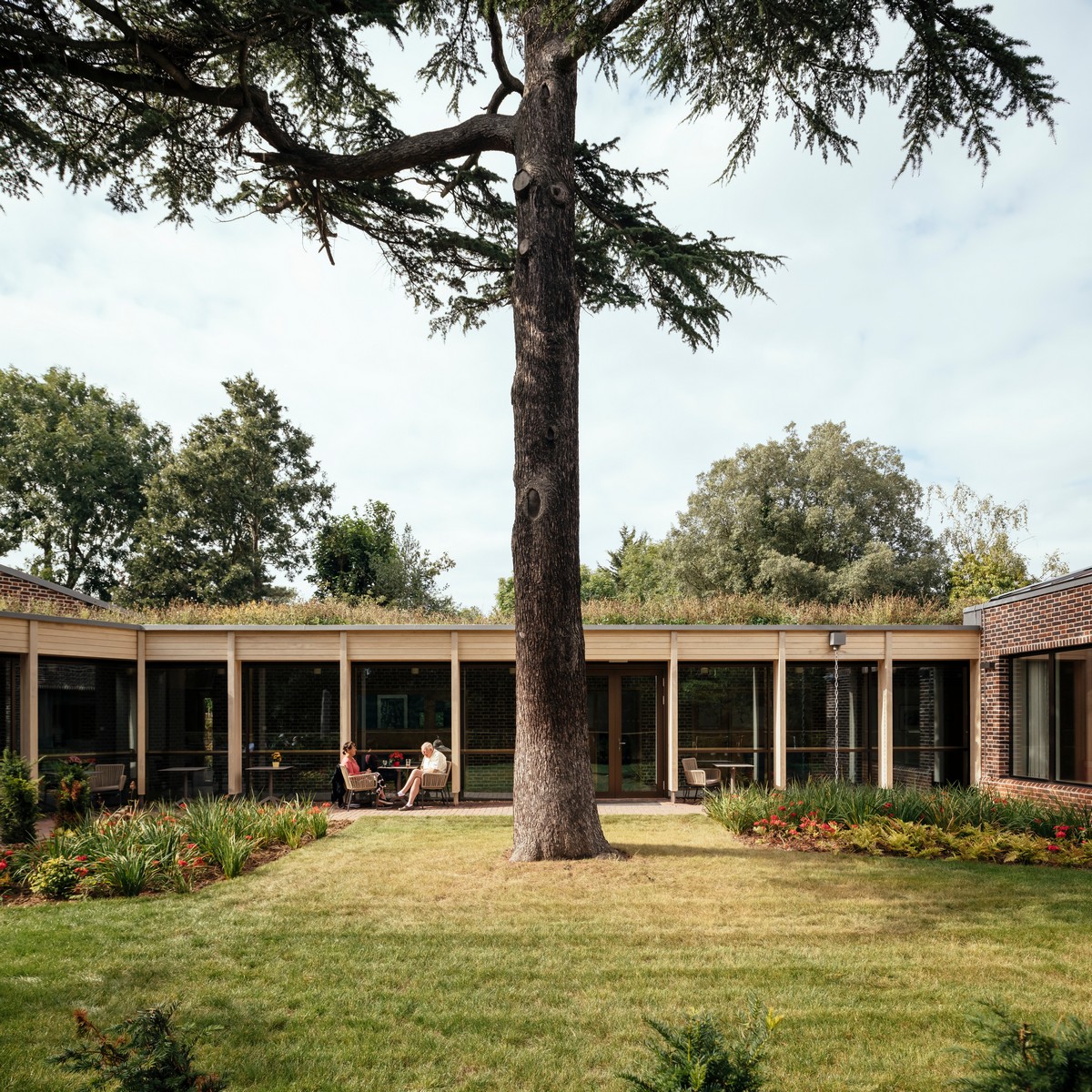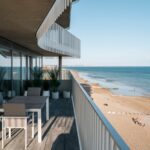Pritzker Prize, Winner, Architecture, Award, Architects, Designer, SANAA, News
Pritzker Architecture Prize 2010
Winner – 2010 – SANAA architects
29 Mar 2010
2010 Pritzker Architecture Prize Laureate
Pritzker Prize Winner 2010 : SANAA, architects
Architectural Partners in Japan Become the 2010 Pritzker Architecture Prize Laureates
Los Angeles, CA – Kazuyo Sejima and Ryue Nishizawa, partners in the architectural firm, SANAA, have been chosen as the 2010 Laureates of the Pritzker Architecture Prize. The formal ceremony for what has come to be known throughout the world as architecture’s highest honor will be held on May 17 on historic Ellis Island in New York. At that time, a $100,000 grant and bronze medallions will be bestowed on the two architects.
New National Gallery of Hungary, Budapest, Hungary, design by SANAA:
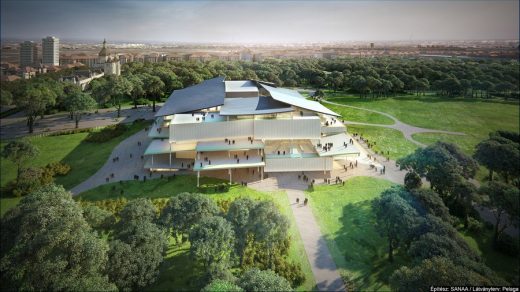
image from architect
New National Gallery of Hungary
In announcing the jury’s choice, Thomas J. Pritzker, chairman of The Hyatt Foundation, elaborated, “This marks the third time in the history of the prize that two architects have been named in the same year. The first was in 1988 when Oscar Niemeyer of Brazil and the late Gordon Bunshaft were so honored, and the second was in 2001, when Jacques Herzog and Pierre de Meuron, partners in a Swiss firm, were selected.”
He continued, “Japanese architects have been chosen three times in the thirty year history of the Pritzker Architecture Prize — the first was the late Kenzo Tange in 1987, then in 1993, Fumihiko Maki was selected, and in 1995, Tadao Ando was the honoree.”
The purpose of the Pritzker Architecture Prize is to honor annually a living architect whose built work demonstrates a combination of those qualities of talent, vision and commitment, which has produced consistent and significant contributions to humanity and the built environment through the art of architecture.
Pritzker Prize jury chairman, The Lord Palumbo quoted from the jury citation to focus on this year’s selection: “For architecture that is simultaneously delicate and powerful, precise and fluid, ingenious but not overly or overtly clever; for the creation of buildings that successfully interact with their contexts and the activities they contain, creating a sense of fullness and experiential richness; for a singular architectural language that springs from a collaborative process that is both unique and inspirational; for their notable completed buildings and the promise of new projects together, Kazuyo Sejima and Ryue Nishizawa are the recipients of the 2010 Pritzker Architecture Prize.”
Taichung City Cultural Center Competition, Taiwan, design by SANAA:
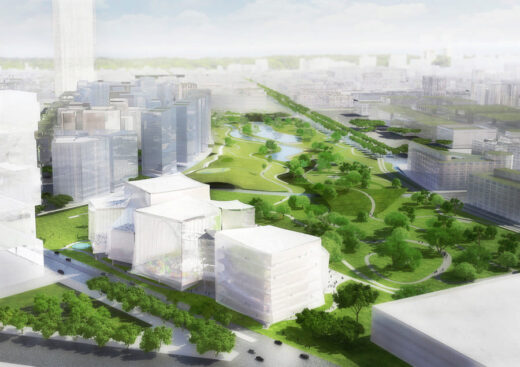
image from architect
Taichung City Cultural Center Competition Winners
While most of their work is in Japan, Sejima and Nishizawa have designed projects in Germany, England, Spain, France, the Netherlands and the United States, under their combined name SANAA. The first SANAA project in the United States began construction in 2004 in Ohio—a Glass Pavilion for the Toledo Museum of Art. Completed in 2006, it houses the museum’s vast collection of glass artworks, reflecting the city’s history when it was a major center of glass production.
While that building was still under construction, the New Museum of New York City broke ground in 2005 at 235 Bowery. Completed in 2007, the building has been described as “a sculptural stack of rectilinear boxes dynamically shifted off-axis around a central steel core.”
The jury citation specifically mentions these projects as well as two projects in Japan: “the O-Museum in Nagano and the 21st Century Muscum of Contemporarry Art in Kanazawa.” The Ogasawara Museum was one of their first projects together. Architectural Partners in Japan Become the 2010 Pritzker Architecture Prize Laureates For publication on or after Monday, March 29, 2010.
The De Kunstline Theater and Cultural Center in Almere, the Netherlands, and a more recent Rolex Learning Center in Lausanne, Switzerland are also major projects of SANAA. Other works in Japan include the Naoshima Ferry Terminal and the Christian Dior Building in Tokyo.
In Essen, Germany, in 2006, the Zollverein School of Management and Design was inaugurated in a new building designed by SANAA on an historical coal mining site. The building is described as an oversized cube (approximately 114 feet in each dimension) with an unusual arrangement of openings and windows of four different sizes.
The Serpentine Pavilion in London, their first built project in the United Kingdom, was in place for three months on the gallery’s lawn — the ninth such commission in the Serpentine’s series of pavilions. In France, a branch of the Louvre Museum in Lens will comprise some 300,000 square feet of construction.
In Valencia, Spain, SANAA provided a unique expansion solution to IVAM (Valencian Institute of Modern Art) in which their existing building housing eight galleries will be completely enclosed by a translucent skin covering an entire block, and thus creating new indoor/outdoor public spaces between the building and the skin. The proposed skin is a light weight perforated metal that allows daylight, wind and rain to pass through. Construction has not yet begun.
Both architects have extensive lists of completed works and projects as individual architects.
Upon learning that she was being honored, Kazuyo Sejima had this reaction: “I am thrilled to receive such an honor. I would like to thank the Pritzker (Hyatt) foundation, the jury members, the clients who have worked with us, and all of our collaborators. I have been exploring how I can make architecture that feels open, which I feel is important for a new generation of architecture. With this prize I will continue trying to make wonderful architecture.”
And a similar reaction from Ryue Nishizawa: “I receive this wonderful prize with great humility. I am very honored and at the same time very surprised. I receive and understand this prize as encouragement for our efforts. Every time I finish a building I revel in possibilities and at the same time reflect on what has happened. Each project becomes my motivation for the next new project. In the same way this wonderful prize has given me a dynamic energy that I have never felt before. I thank you very much.”
The distinguished jury that selected the 2010 Laureates consists of its chairman, Lord Palumbo, internationally known architectural patron of London, chairman of the trustees, Serpentine Gallery, former chairman of the Arts Council of Great Britain, former chairman of the Tate Gallery Foundation, and former trustee of the Mies van der Rohe Archive at the Museum of Modern Art, New York; and alphabetically: Alejandro Aravena, architect and executive director of Elemental in Santiago, Chile; Rolf Fehlbaum, chairman of the board of Vitra in Basel, Switzerland; Carlos Jimenez, professor, Rice University School of Architecture, principal, Carlos Jimenez Studio in Houston, Texas; Juhani Pallasmaa, architect, professor and author of Helsinki, Finland; Renzo Piano, architect and Pritzker Laureate, of Paris, France and Genoa, Italy; and Karen Stein, writer, editor and architectural consultant in New York. Martha Thorne, associate dean for external relations, IE School of Architecture, Madrid, Spain, who is executive director of the prize, augmented the jury citation, saying, “The architecture 5 of Sejima and Nishizawa explores the ideas of lightness and transparency and pushes the boundaries of these concepts to new extremes.”
In addition to the previous laureates already mentioned, the late Philip Johnson was the first Pritzker Laureate in 1979. The late Luis Barragán of Mexico was named in 1980. The late James Stirling of the United Kingdom was elected in 1981, Kevin Roche in 1982, Ieoh Ming Pei in 1983, and Richard Meier in 1984. Hans Hollein of Austria was the 1985 Laureate. Gottfried Böhm of Germany received the prize in 1986. Robert Venturi received the honor in 1991, and Alvaro Siza of Portugal in 1992.
Christian de Portzamparc of France was elected Pritzker Laureate in 1994. Frank Gehry of the United States was the recipient in 1989, the late Aldo Rossi of Italy in 1990. In 1996, Rafael Moneo of Spain was the Laureate; in 1997 the late Sverre Fehn of Norway; in 1998 Renzo Piano of Italy, in 1999 Sir Norman Foster of the UK, and in 2000, Rem Koolhaas of the Netherlands. Australian Glenn Murcutt received the prize in 2002.
The late Jørn Utzon of Denmark was honored in 2003; Zaha Hadid of the UK in 2004; and Thom Mayne of the United States in 2005. Paulo Mendes da Rocha of Brazil was the Laureate in 2006, and Richard Rogers received the prize in 2007. Jean Nouvel of France was the Laureate in 2008. Last year, Peter Zumthor of Switzerland received the award.
The field of architecture was chosen by the Pritzker family because of their keen interest in building due to their involvement with developing the Hyatt Hotels around the world; also because architecture was a creative endeavor not included in the Nobel Prizes. The procedures were modeled after the Nobels, with the final selection being made by the international jury with all deliberations and voting in secret. Nominations are continuous from year to year with hundreds of nominees from countries all around the world being considered each year.
Pritzker Prize information from The Pritzker Prize 290310
Pritzker Architecture Prize Laureate 2010 2010 : Citation from the Jury + The Jury
Pritzker Prize Winner 2010 : SANAA, architects
Location: Los Angeles, CA, USA
Pritzker Prize Awards
Pritzker Prize : main page with current winner information
Pritzker Architecture Prize Laureate 2011 Citation from the Jury + The Jury + Eduardo Souto de Moura information
Pritzker Prize Winner 2009 : Peter Zumthor
Key Architecture Awards
World Architecture Festival Awards
Comments / photos for the Pritzker Architecture Prize Laureate 2010 page welcome

